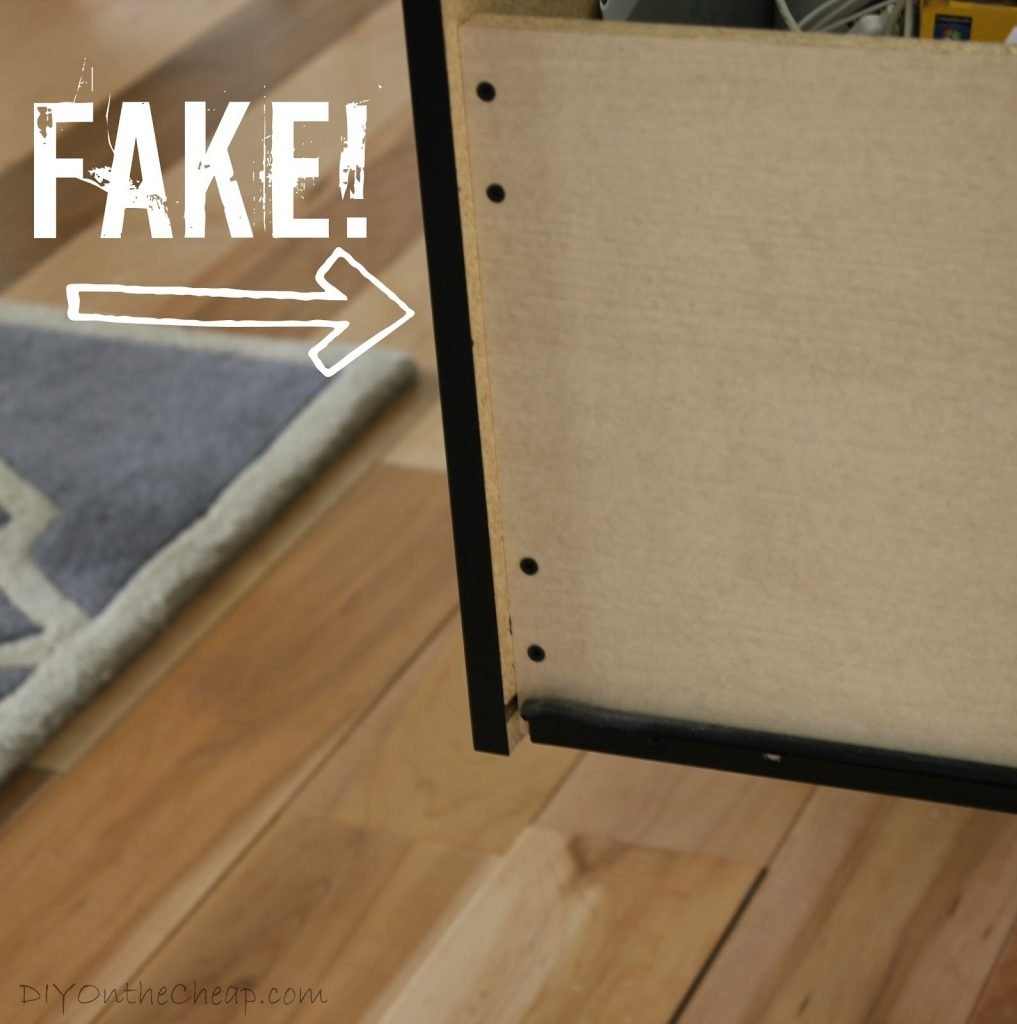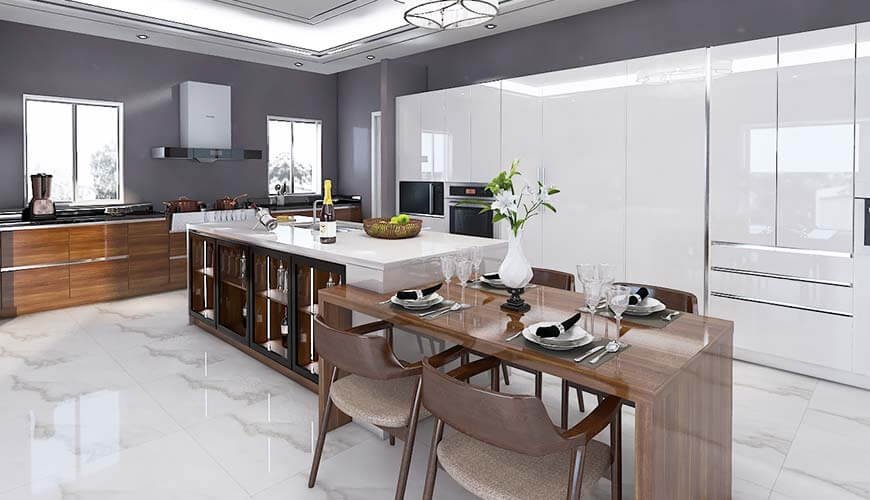Inspect the grain pattern and edges. Real wood has natural, irregular grains and visible end grain.
Identifying real wood kitchen cabinets is crucial for both aesthetics and durability. Real wood offers unique grain patterns, adding character to your kitchen. Unlike laminate or veneer, real wood feels solid and sturdy. Look for visible end grains at the edges, a hallmark of genuine wood.
Scratches on real wood reveal the same material underneath, while laminates expose a different core. Real wood cabinets are heavier compared to their synthetic counterparts. These factors can help you determine if your kitchen cabinets are made from real wood, ensuring you get the quality and longevity you desire.
Table of Contents
ToggleIdentifying Real Wood
Real wood cabinets add beauty and value to your kitchen. Knowing if your cabinets are real wood can be tricky. This guide will help you identify real wood cabinets. We will look at wood characteristics and common wood types.<h3Wood Characteristics
Real wood has distinct features that make it unique. Here are some key characteristics:
- Grain Patterns: Real wood has natural grain patterns. These patterns are unique and varied.
- Weight: Real wood is heavier than particleboard or MDF. Lift a cabinet door to feel the weight.
- Texture: Run your hand over the surface. Real wood has a natural texture, unlike smooth synthetic materials.
- Smell: Real wood has a natural, woody smell. Synthetic materials lack this aroma.
Common Wood Types
Different woods are used for kitchen cabinets. Below are some common types:
| Wood Type | Characteristics |
|---|---|
| Oak | Durable, prominent grain, light to medium brown. |
| Maple | Hardwood, fine grain, light color. |
| Cherry | Rich color, smooth grain, darkens with age. |
| Birch | Strong, fine grain, pale color. |
| Hickory | Very hard, prominent grain, color variation. |
Recognizing these characteristics will help you identify real wood. Always look closely and trust your senses.
“`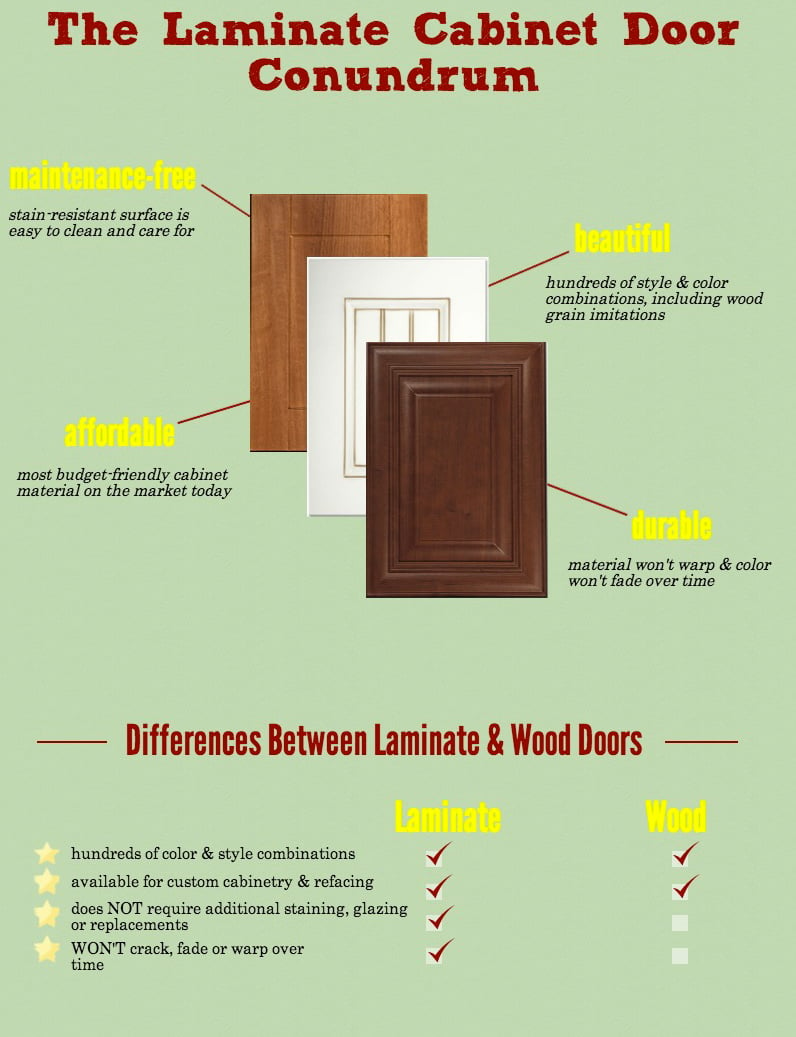
Credit: blog.kitchenmagic.com
Surface Examination
Evaluating the surface of your kitchen cabinets can reveal if they are real wood. By inspecting various aspects such as texture, grain patterns, and imperfections, you can determine the material used. This section will help you identify the authenticity of your cabinets.
Texture And Grain
Real wood has a unique texture and grain pattern. You can feel the texture by running your fingers over the surface. Solid wood usually feels warmer and more natural than synthetic materials.
Look closely at the grain patterns. Natural wood grains are irregular and vary across the surface. These grains form intricate and random patterns, a clear indication of real wood. In contrast, synthetic materials often have repetitive or uniform patterns.
Visible Imperfections
Real wood often has natural imperfections. These include small knots, color variations, and fine cracks. Such imperfections add character and authenticity to your cabinets.
Synthetic materials are usually flawless. They lack the minor defects that real wood possesses. If you see consistent perfection, the material is likely synthetic.
- Knots: Small, dark spots in the wood.
- Color Variations: Subtle differences in color across the surface.
- Fine Cracks: Tiny cracks that naturally form over time.
Examine your cabinets for these imperfections to determine their authenticity.
Construction Details
Construction details provide vital clues about your kitchen cabinets. By examining joinery techniques and back panels, you can determine if they are real wood.
Joinery Techniques
Real wood cabinets often use specific joinery techniques. Look for dovetail joints, which indicate high-quality craftsmanship. Dovetail joints are a series of interlocking pins and tails. They provide strong and durable connections.
Another common method is mortise and tenon. This technique involves a protruding tenon fitting into a corresponding mortise. It’s a hallmark of solid wood construction.
Check for dowel joints, where wooden pegs join pieces together. Dowel joints are less common but still indicate real wood. They provide a secure and precise fit.
Avoid cabinets with staples or nails at the joints. These are signs of particleboard or MDF construction. Real wood rarely uses such methods.
Back Panel Inspection
The back panel of your cabinets can reveal a lot. Real wood cabinets have solid wood or plywood back panels. These materials add strength and durability.
Inspect the back panel material. If it feels flimsy or cardboard-like, it’s likely not real wood. Look for a thick, solid feel when you press on it.
Examine the back panel’s attachment method. Real wood cabinets use screws or dovetail joints. Particleboard or MDF cabinets often use staples or glue.
Avoid cabinets with thin, flexible back panels. These are not indicative of real wood construction.
| Joinery Technique | Real Wood Indicator |
|---|---|
| Dovetail Joints | Yes |
| Mortise and Tenon | Yes |
| Dowel Joints | Yes |
| Staples or Nails | No |
By inspecting these construction details, you can determine if your kitchen cabinets are real wood. Real wood cabinets offer superior durability and craftsmanship.
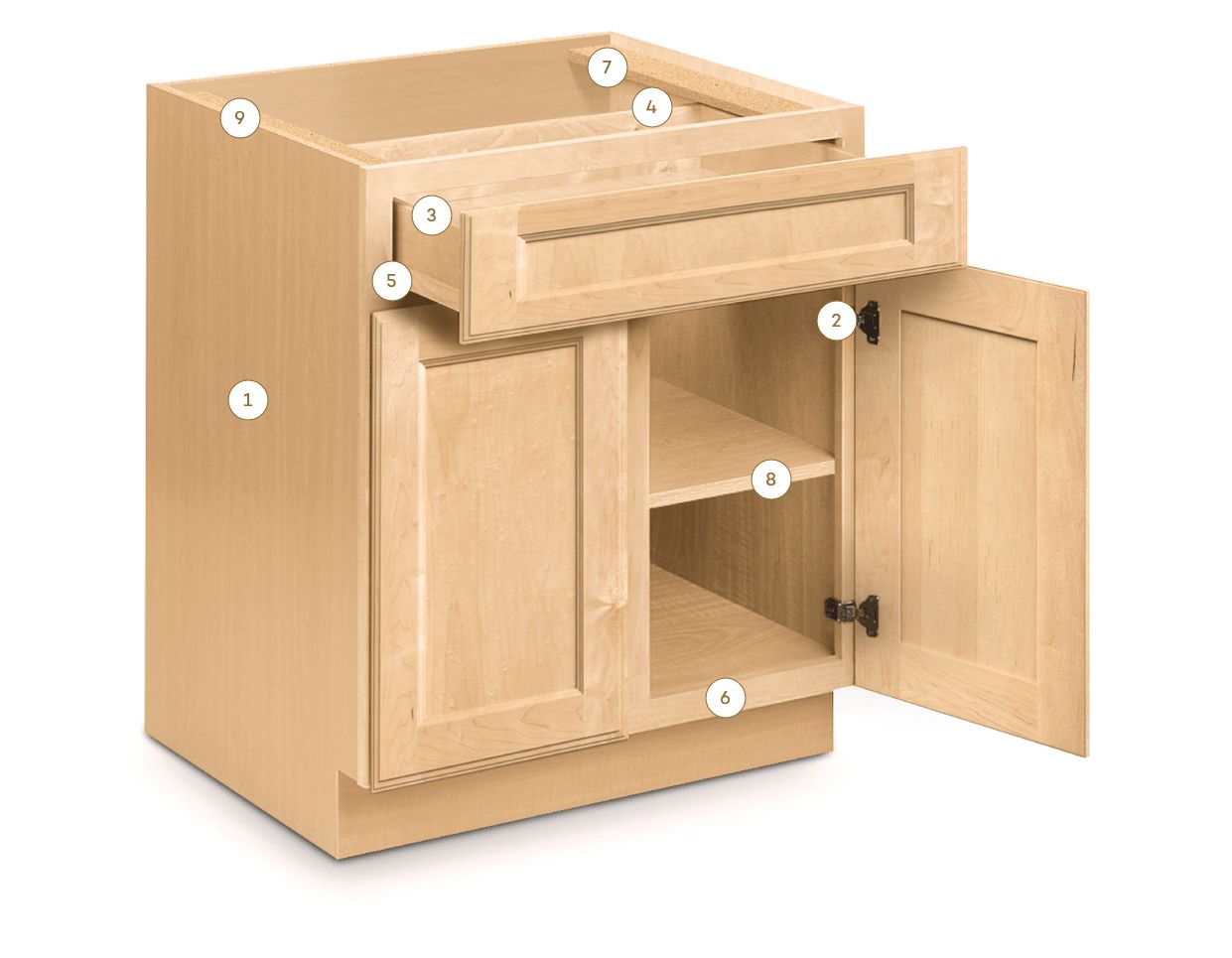
Credit: www.kraftmaid.com
Weight And Density
Identifying real wood kitchen cabinets can be tricky. One way to tell is by assessing their weight and density. Real wood has unique characteristics that set it apart from other materials. This section will explore these aspects in detail.
Heft Test
Real wood cabinets are heavier than particleboard or MDF cabinets. You can perform a simple heft test to check the weight. Lift one of the cabinet doors. Does it feel substantial? Real wood feels solid and hefty. This is due to its natural density. MDF and particleboard, on the other hand, feel lighter. These materials are less dense and often used as cost-saving alternatives.
Comparing Materials
Let’s compare different materials to understand their weight and density differences.
| Material | Weight | Density |
|---|---|---|
| Real Wood | Heavy | High |
| MDF | Moderate | Medium |
| Particleboard | Light | Low |
As shown in the table, real wood is heavy and dense. MDF is moderately heavy with medium density. Particleboard is the lightest and least dense.
There are also visual and tactile differences. Real wood has a natural grain pattern. MDF and particleboard have smoother, more uniform surfaces. These differences can help you identify the material of your cabinets.
Finish And Coating
The finish and coating on your kitchen cabinets can reveal if they are real wood. Real wood cabinets often feature specific types of finishes that differentiate them from synthetic materials. Understanding these finishes can help you identify the authenticity of your kitchen cabinets.
Varnish Vs. Veneer
Varnish is a clear coating applied to real wood cabinets. It enhances the wood’s natural grain and offers protection. Real wood cabinets with varnish will have a smooth, glossy surface.
Veneer is a thin layer of wood or laminate glued to the cabinet’s surface. It can mimic real wood’s appearance but lacks the depth and grain variations. Veneered cabinets may feel less solid and have visible seams.
| Feature | Varnish | Veneer |
|---|---|---|
| Material | Clear coating on wood | Thin wood or laminate layer |
| Appearance | Smooth and glossy | Can mimic wood |
| Durability | High | Varies |
Natural Wood Stains
Natural wood stains penetrate the wood, highlighting its unique grain patterns. These stains come in various shades, enhancing the wood’s natural beauty.
Real wood cabinets with stains will have visible grain patterns and slight imperfections. Synthetic materials often have uniform patterns, lacking the charm of natural wood.
- Look for varied grain patterns.
- Check for slight imperfections.
- Feel the texture; real wood is distinct.
Real wood cabinets often age gracefully. The finish may develop a rich patina over time, adding character.
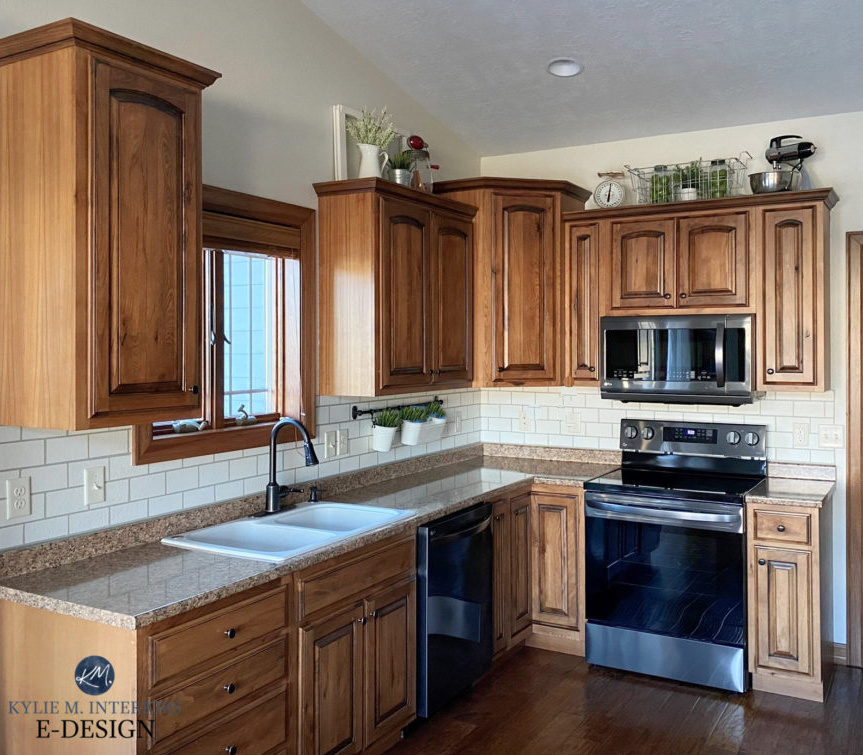
Credit: www.kylieminteriors.ca
Sound Test
The Sound Test is an easy way to identify real wood cabinets. This test involves listening to the sound produced by tapping the cabinet’s surface. Real wood has distinct sound characteristics that set it apart from other materials.
Tapping Method
To perform the Tapping Method, use your knuckles or a small object. Tap on different sections of the cabinet, such as the door, sides, and back. Make sure to tap gently but firmly.
- Tap on the cabinet door.
- Move to the sides and back.
- Listen to the sound carefully.
Echo Characteristics
The sound produced by real wood will have unique Echo Characteristics. Real wood often emits a warm, solid sound. Listen for a rich, deep echo that suggests density and natural material.
| Material | Sound Characteristics |
|---|---|
| Real Wood | Warm, solid, rich echo |
| Plywood | Dull, less resonant |
| Particleboard | Flat, hollow |
By understanding these sound differences, you can easily identify real wood cabinets. Performing the Sound Test provides a quick and effective way to ensure your kitchen cabinets are made from genuine wood.
Expert Inspection
Determining if your kitchen cabinets are real wood can be tricky. An expert inspection offers precise and reliable results. Professionals use their experience and tools to provide accurate assessments.
Consulting A Professional
Consulting a professional is a smart choice. An experienced carpenter or cabinet maker knows what to look for. They can identify wood types and spot imitations.
Here are some benefits of hiring a professional:
- Accurate identification of wood types.
- Detection of hidden damage or wear.
- Advice on maintenance and care.
Certified Wood Tests
Certified wood tests are another reliable method. These tests can confirm the authenticity of your cabinets. Professionals use various techniques to test the wood.
Common methods include:
- Chemical tests: Reveal the presence of certain wood types.
- Moisture tests: Determine the wood’s moisture content.
- Grain pattern analysis: Compare the grain patterns to known samples.
| Method | Description |
|---|---|
| Chemical Tests | Identify specific wood types. |
| Moisture Tests | Check the moisture content in the wood. |
| Grain Pattern Analysis | Compare patterns to known samples. |
Hiring professionals for certified tests ensures accuracy. It provides peace of mind and confirms the authenticity of your kitchen cabinets.
Diy Identification Tools
Identifying if your kitchen cabinets are real wood can be simple. Using DIY Identification Tools can save you time and money. Below are some effective tools to help you determine the material of your cabinets.
Magnifying Glass
A magnifying glass is a handy tool for wood identification. Follow these steps:
- Examine the wood grain closely.
- Real wood has inconsistent patterns. Look for natural imperfections.
- Check the edges and corners. Real wood has subtle variations.
A magnifying glass helps you spot these details easily. It’s a quick and simple way to identify real wood.
Moisture Meter
A moisture meter is another effective tool. It measures the moisture content in the wood. Here’s how you can use it:
- Turn on the moisture meter.
- Place the sensor on the wood surface.
- Read the moisture level displayed on the screen.
Real wood has a moisture level between 6% to 12%. This tool is accurate and reliable.
Using these tools makes the identification process easier. Both tools provide valuable information about your kitchen cabinets. They help you determine if they are made of real wood.
Frequently Asked Questions
How To Identify Real Wood Cabinets?
Check for wood grain patterns and knots. Real wood has unique textures and imperfections.
What Are Signs Of Fake Wood Cabinets?
Uniform patterns and smooth surfaces often indicate fake wood or laminate materials.
Do Real Wood Cabinets Have Specific Smells?
Yes, real wood emits a natural, earthy aroma, unlike synthetic materials which might smell like chemicals.
Are Real Wood Cabinets Heavier?
Real wood is denser and heavier compared to engineered wood or laminate materials.
Can I See Wood Grain In Real Wood?
Yes, real wood has distinct, visible grain patterns that are unique to each piece.
Do Real Wood Cabinets Dent Easily?
Real wood can dent or scratch more easily than synthetic materials, which are designed to be more durable.
Can I Use The Water Test?
Yes, real wood absorbs water and may darken temporarily. Laminates repel water and remain unchanged.
Do Real Wood Cabinets Change Over Time?
Real wood can develop a patina, showing wear and aging, adding character over time.
How Do Joints Differ In Real Wood?
Real wood cabinets often use dovetail joints, while fake wood might use dowels or staples.
Are Real Wood Cabinets More Expensive?
Yes, real wood cabinets are typically more costly due to the quality and durability of the material.
Conclusion
Confirming if your kitchen cabinets are real wood is straightforward with these tips. Check for wood grain patterns, weight, and joinery. Real wood offers durability and a timeless look. Use these methods to ensure you have genuine wood cabinets, enhancing your kitchen’s value and aesthetic appeal.
Enjoy the beauty of authentic wood!
